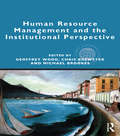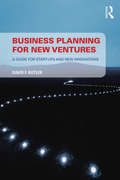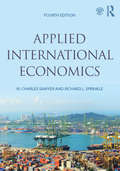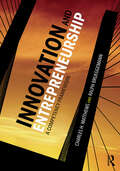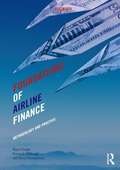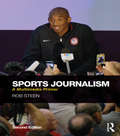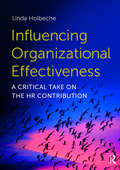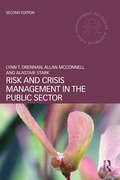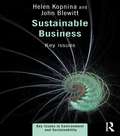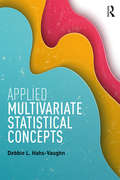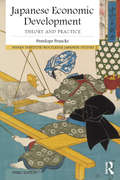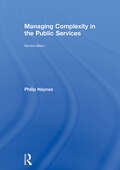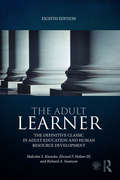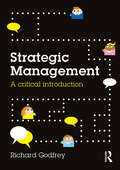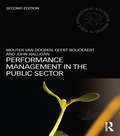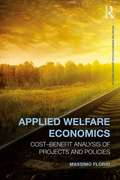- Table View
- List View
Human Resource Management and the Institutional Perspective
by Geoffrey Wood Chris Brewster Michael BrookesOne of the most influential debates across business and management studies has centered on the relative impact of institutions on the fortunes of firms and nations. However, analyses have primarily focused on institutional effects on societal features, rather than actual firm practices. This volume brings together recent trends in comparative institutional analysis with a rich body of data on firm-level human resource management practice, consolidating and extending more than a decade of research on the topic. Human Resource Management and the Institutional Perspective explores the overlapping and distinct elements in work and employment relations both within and across country lines. The authors focus on intra-firm relations, internal diversity within varieties of capitalism, and the uneven and experimental nature of systemic change, all the while employing an impressive level of theoretical rigor and empirical evidence. In a single volume, this text unites soundly based, theoretically strong and empirically new chapters that bring advances in institutional theory to bear on the subject of international and comparative human resource management. This book is a valuable resource for students and scholars interested in contemporary developments in institutional theory, the relationship between regulation and practice, and innovation and continuity in human resource management.
Research Methods for Sports Studies: Third Edition
by Ian JonesResearch Methods for Sports Studies is a comprehensive, engaging and practical textbook that provides a complete grounding in both qualitative and quantitative research methods for the sports studies student. Leading the reader step-by-step through the entire research process, from identifying a research question and collecting and analyzing data to writing the research report, it is richly illustrated throughout with sport-related case-studies and examples from around the world. Now in a fully revised, updated and expanded third edition, the book includes completely new chapters on using social media and conducting on-line research, as well as expanded coverage of key topics such as conducting a literature review, making the most of statistics, research ethics and presenting research. Research Methods for Sports Studies is designed to be a complete and self-contained companion to any research methods course and contains a wealth of useful features, such as highlighted definitions of key terms, revision questions and practical research exercises. An expanded companion website offers additional material for students and instructors, including web links, multiple choice revision questions, an interactive glossary, PowerPoint slides and additional learning activities for use in and out of class. This is an essential read for any student undertaking a dissertation or research project as part of their studies in sport, exercise and related fields.
Research Methods for Sports Studies: Third Edition
by Ian JonesResearch Methods for Sports Studies is a comprehensive, engaging and practical textbook that provides a complete grounding in both qualitative and quantitative research methods for the sports studies student. Leading the reader step-by-step through the entire research process, from identifying a research question and collecting and analyzing data to writing the research report, it is richly illustrated throughout with sport-related case-studies and examples from around the world. Now in a fully revised, updated and expanded third edition, the book includes completely new chapters on using social media and conducting on-line research, as well as expanded coverage of key topics such as conducting a literature review, making the most of statistics, research ethics and presenting research. Research Methods for Sports Studies is designed to be a complete and self-contained companion to any research methods course and contains a wealth of useful features, such as highlighted definitions of key terms, revision questions and practical research exercises. An expanded companion website offers additional material for students and instructors, including web links, multiple choice revision questions, an interactive glossary, PowerPoint slides and additional learning activities for use in and out of class. This is an essential read for any student undertaking a dissertation or research project as part of their studies in sport, exercise and related fields.
Business Planning for New Ventures: A guide for start-ups and new innovations
by David ButlerStarting a new business takes a lot of energy and organization. The failure rate is alarmingly high and the task can look herculean at the outset. This new textbook provides a simple guide to help plan a successful new business, taking entrepreneurs and students through the steps required to avoid pitfalls and get a business going. Unlike most entrepreneurship textbooks, the author avoids dwelling on theories in favour of providing effective and practical guidance on how to start and manage a profitable business, with a focus on new ventures operating in high-growth, innovative sectors. Written by an expert with experience in academia and business consulting, this concise textbook will be valuable reading for students of entrepreneurship, new ventures and small business. The practical focus of the book means that it will be useful both for students in the classroom and for entrepreneurs wanting to start a new business.
Business Planning for New Ventures: A guide for start-ups and new innovations
by David ButlerStarting a new business takes a lot of energy and organization. The failure rate is alarmingly high and the task can look herculean at the outset. This new textbook provides a simple guide to help plan a successful new business, taking entrepreneurs and students through the steps required to avoid pitfalls and get a business going. Unlike most entrepreneurship textbooks, the author avoids dwelling on theories in favour of providing effective and practical guidance on how to start and manage a profitable business, with a focus on new ventures operating in high-growth, innovative sectors. Written by an expert with experience in academia and business consulting, this concise textbook will be valuable reading for students of entrepreneurship, new ventures and small business. The practical focus of the book means that it will be useful both for students in the classroom and for entrepreneurs wanting to start a new business.
Applied International Economics
by W. Charles Sawyer Richard L. SprinkleApplied International Economics, 4th Edition offers a modern and accessible treatment of international economics, shifting the emphasis from pure theory to the application of theory by using some of the key tools of economic analysis. This new edition of the text formerly known as International Economics makes the real-life application of international economics clearer than ever before, and focuses on the basics that students will need in order to analyse information on the world economy throughout their future careers. The new edition has been refocused, revised and thoroughly updated. Key features include: A new chapter on the firm in international trade accompanies a greater focus on firms in the world economy, how trade influences income inequality and how businesses can apply principles of international economics.? New or expanded chapter subsections on topics including the intersection of international economics and international business; money, interest rates, and the exchange rate; and the dynamic gains from trade. Replacement and expansion of case studies to bring them fully up to date. Chapters on economic development in both the international trade and finance sections on the book to reflect the increasing importance of low- and middle-income countries in the world economy. A streamlined treatment of Purchasing Power Parity, leading into the concept of the real exchange rate.? Expanded treatment of the Eurozone and the Eurozone crisis. Written in a thorough and engaging style, the book covers topics at a level appropriate for students specializing in business or international relations, as well as for economics students. Along with a wealth of case studies and real-life examples, the book offers extensive pedagogy including a companion website, end of chapter summaries, explanations of key concepts and terms, problem sets and additional readings.
Applied International Economics
by W. Charles Sawyer Richard L. SprinkleApplied International Economics, 4th Edition offers a modern and accessible treatment of international economics, shifting the emphasis from pure theory to the application of theory by using some of the key tools of economic analysis. This new edition of the text formerly known as International Economics makes the real-life application of international economics clearer than ever before, and focuses on the basics that students will need in order to analyse information on the world economy throughout their future careers. The new edition has been refocused, revised and thoroughly updated. Key features include: A new chapter on the firm in international trade accompanies a greater focus on firms in the world economy, how trade influences income inequality and how businesses can apply principles of international economics.? New or expanded chapter subsections on topics including the intersection of international economics and international business; money, interest rates, and the exchange rate; and the dynamic gains from trade. Replacement and expansion of case studies to bring them fully up to date. Chapters on economic development in both the international trade and finance sections on the book to reflect the increasing importance of low- and middle-income countries in the world economy. A streamlined treatment of Purchasing Power Parity, leading into the concept of the real exchange rate.? Expanded treatment of the Eurozone and the Eurozone crisis. Written in a thorough and engaging style, the book covers topics at a level appropriate for students specializing in business or international relations, as well as for economics students. Along with a wealth of case studies and real-life examples, the book offers extensive pedagogy including a companion website, end of chapter summaries, explanations of key concepts and terms, problem sets and additional readings.
Innovation and Entrepreneurship: A Competency Framework
by Charles H. Matthews Ralph BrueggemannThis book presents a new model, the competency framework, for students, innovators, entrepreneurs, managers, and anyone who wants to better understand the dynamic world of innovation and entrepreneurship. Focused on both the individual and strategic organizational level, this book is about people and the competencies each person needs to learn to be successful in creating a more dynamic future. Matthews and Brueggemann’s framework for innovation and entrepreneurship competencies empowers individuals to excel at innovation and new venture creation. It provides a practical guide and clear and concise understanding of the knowledge, skills, attitudes, and experiences that are needed to increase imagination, creativity, innovation and new venture creation capability. Innovation and Entrepreneurship will be attractive for students of entrepreneurship, innovation, management and cross-disciplinary classes, such as design thinking. Presented in a modular format, Innovation & Entrepreneurship informs the future direction of people and technology, as well as the educational systems producing the next generation of innovators and entrepreneurs. Based on extensive academic research, this book is organized into two sections: Twelve innovation elements and twelve competency categories. The elements are the foundation and the competency categories are the building blocks that inform our path toward a more precise understanding of how innovation and entrepreneurship plays an important role in economic development and our daily lives.
Foundations of Airline Finance: Methodology and Practice
by Bijan Vasigh Kenneth Fleming Barry HumphreysIn recent years the airline industry has experienced severe volatility in earnings, with airlines recording periods of substantial profits that are closely followed by periods of financial distress. This trend has continued into the new millennium, with numerous examples of airlines across the globe entering bankruptcy protection or liquidating. The text provides an introduction to both the basics of finance and the particular intricacies of airline finance where there can be significant fluctuations in both revenues and costs. This new edition also includes: capital budgeting management of current assets financial risk analysis fuel hedging aircraft leasing This textbook contains chapters that cover unique aspects of the aviation financial decision-making process. These include a rigorous and structured presentation of the buy versus lease decision that is prevalent in the industry, a valuation process for aviation assets, the recent trend toward privatization and the difficulty inherent in the valuation of a publicly-owned or semi-publicly owned asset. The Foundations of Airline Finance, now in its second edition, is an introductory text that can be used either as a general financial text or in a specialized class that deals with aviation finance in particular.
Foundations of Airline Finance: Methodology and Practice
by Bijan Vasigh Kenneth Fleming Barry HumphreysIn recent years the airline industry has experienced severe volatility in earnings, with airlines recording periods of substantial profits that are closely followed by periods of financial distress. This trend has continued into the new millennium, with numerous examples of airlines across the globe entering bankruptcy protection or liquidating. The text provides an introduction to both the basics of finance and the particular intricacies of airline finance where there can be significant fluctuations in both revenues and costs. This new edition also includes: capital budgeting management of current assets financial risk analysis fuel hedging aircraft leasing This textbook contains chapters that cover unique aspects of the aviation financial decision-making process. These include a rigorous and structured presentation of the buy versus lease decision that is prevalent in the industry, a valuation process for aviation assets, the recent trend toward privatization and the difficulty inherent in the valuation of a publicly-owned or semi-publicly owned asset. The Foundations of Airline Finance, now in its second edition, is an introductory text that can be used either as a general financial text or in a specialized class that deals with aviation finance in particular.
Sports Journalism: A Multimedia Primer
by Rob SteenSports Journalism is a comprehensive guide to the purpose, principles and practice of this unique profession. Now in a fully revised and updated second edition, including important new material on social media and the rise of on-line journalism, this is still the only book to explore the fundamentals of sports reporting across every media platform. Combining an introduction to practical skills, contextual discussion of the changing media environment, and important case studies, including the ground-breaking story of Lance Armstrong, the book covers key topics such as: essential relationships in sports journalism - networking and the Sports Desk print journalism for magazines, tabloids, broadsheets and the internet live action – news, radio and television sports journalism effective research – managing and accessing sources, information, statistics practical skills for managing schedules and meeting deadlines working with sports agents and PR professionals getting the best from press conferences and interviews. Laced with revealing anecdotes from the author's own thirty years’ experience of domestic and international sport journalism, and including questions in each chapter to encourage critical reflection and notes on further reading, Sports Journalism is the ultimate insider’s guide and an invaluable student companion.
Sports Journalism: A Multimedia Primer
by Rob SteenSports Journalism is a comprehensive guide to the purpose, principles and practice of this unique profession. Now in a fully revised and updated second edition, including important new material on social media and the rise of on-line journalism, this is still the only book to explore the fundamentals of sports reporting across every media platform. Combining an introduction to practical skills, contextual discussion of the changing media environment, and important case studies, including the ground-breaking story of Lance Armstrong, the book covers key topics such as: essential relationships in sports journalism - networking and the Sports Desk print journalism for magazines, tabloids, broadsheets and the internet live action – news, radio and television sports journalism effective research – managing and accessing sources, information, statistics practical skills for managing schedules and meeting deadlines working with sports agents and PR professionals getting the best from press conferences and interviews. Laced with revealing anecdotes from the author's own thirty years’ experience of domestic and international sport journalism, and including questions in each chapter to encourage critical reflection and notes on further reading, Sports Journalism is the ultimate insider’s guide and an invaluable student companion.
Influencing Organizational Effectiveness: A Critical Take on the HR Contribution
by Linda HolbecheIn this book Linda Holbeche offers an historical narrative on the changing landscape of work since the 1980s and considers how definitions of organizational effectiveness have changed over time. She considers the characteristics and effects of the neo-liberal work culture of new capitalism, and how HRM practices have contributed to shaping this work culture. Influencing Organizational Effectiveness challenges mainstream thinking around business strategy, change and organizational effectiveness, and about the roles of HRM and management. While the overall tone of the book is critical, Holbeche argues that HRM can play an active role in giving voice to employees and advancing organizational effectiveness. Grounded in research, this book includes reflective questions, case studies and helpful guidelines to support HRM and organizational development professionals and master's-level students. It illustrates what ‘better’ might look like and how HRM can contribute to a new definition of effectiveness which is aligned to the needs of modern organizations.
Influencing Organizational Effectiveness: A Critical Take on the HR Contribution
by Linda HolbecheIn this book Linda Holbeche offers an historical narrative on the changing landscape of work since the 1980s and considers how definitions of organizational effectiveness have changed over time. She considers the characteristics and effects of the neo-liberal work culture of new capitalism, and how HRM practices have contributed to shaping this work culture. Influencing Organizational Effectiveness challenges mainstream thinking around business strategy, change and organizational effectiveness, and about the roles of HRM and management. While the overall tone of the book is critical, Holbeche argues that HRM can play an active role in giving voice to employees and advancing organizational effectiveness. Grounded in research, this book includes reflective questions, case studies and helpful guidelines to support HRM and organizational development professionals and master's-level students. It illustrates what ‘better’ might look like and how HRM can contribute to a new definition of effectiveness which is aligned to the needs of modern organizations.
Risk and Crisis Management in the Public Sector
by Lynn T Drennan Allan McConnell Alastair StarkEvery decision that is made by managers and policy-makers in a public sector organization requires an evaluation and a judgement of the risks involved. This vital requirement has been recognised in the growth of risk management. However, risks can never be fully prevented, which means that public managers also have to be crisis managers. Today’s crises develop in unseen ways; they escalate rapidly and transform through the interdependencies of modern society, and their frequency is growing: the global financial crisis, the European volcanic ash cloud, the Japanese tsunami and subsequent Fukushima nuclear plant meltdown, the Christchurch earthquake and the Queensland floods. All highlight the extreme challenges that public sector organizations across the world have had to face in recent years. Risk and Crisis Management in the Public Sector Second Edition responds to these challenges by presenting the only guide for public managers and public management students which combines lessons about risk and crisis management together in a single, accessible text. It equips readers and public managers with the knowledge and skills to understand key issues and debates, as well as the capacity to treat risks and better prepare for, respond to and recover from crisis episodes. This exciting new edition enhances the original text with contemporary cases and a greater focus on the international, trans-boundary and multi-agency dimensions of risk and crisis management. These enhancements reflect the fact that today’s public manager must increasingly operate within a global and interdependent governance context.
Risk and Crisis Management in the Public Sector
by Lynn T Drennan Allan McConnell Alastair StarkEvery decision that is made by managers and policy-makers in a public sector organization requires an evaluation and a judgement of the risks involved. This vital requirement has been recognised in the growth of risk management. However, risks can never be fully prevented, which means that public managers also have to be crisis managers. Today’s crises develop in unseen ways; they escalate rapidly and transform through the interdependencies of modern society, and their frequency is growing: the global financial crisis, the European volcanic ash cloud, the Japanese tsunami and subsequent Fukushima nuclear plant meltdown, the Christchurch earthquake and the Queensland floods. All highlight the extreme challenges that public sector organizations across the world have had to face in recent years. Risk and Crisis Management in the Public Sector Second Edition responds to these challenges by presenting the only guide for public managers and public management students which combines lessons about risk and crisis management together in a single, accessible text. It equips readers and public managers with the knowledge and skills to understand key issues and debates, as well as the capacity to treat risks and better prepare for, respond to and recover from crisis episodes. This exciting new edition enhances the original text with contemporary cases and a greater focus on the international, trans-boundary and multi-agency dimensions of risk and crisis management. These enhancements reflect the fact that today’s public manager must increasingly operate within a global and interdependent governance context.
Sustainable Business: Key Issues
by Helen Kopnina John BlewittSustainable Business: Key Issues is the first comprehensive introductory-level textbook to address the interface between environmental challenges and business solutions to provide an overview of the basic concepts of sustainability, sustainable business, and business ethics. The book introduces students to the background and key issues of sustainability and suggests ways in which these concepts can be applied in business practice. Though the book takes a business perspective, it is interdisciplinary in its nature and draws on knowledge from socio-economic, political, and environmental studies, thereby providing a practical and critical understanding of sustainability in the changing paradigm of global business. It goes beyond the conventional theories of sustainability and addresses critical issues concerned with population, consumption and economic growth. It discusses realistic ways forward, in particular the Circular Economy and Cradle to Cradle frameworks. The book is both a theoretical and practical study guide for undergraduate and postgraduate international students of broad areas of sustainability, teaching ways to recognize opportunities for innovation and entrepreneurship at the intersection of environmental, economic, ethical, and social systems. It takes a strategic approach in applying the power of business methods and policy to address issues of global importance such as climate change, poverty, ecosystem degradation and human rights. This textbook is essential reading for students of business, management and sustainability courses. It is written in an engaging and accessible style, with each chapter including case studies, discussion questions, end of chapter summaries and suggestions for further reading.
Sustainable Business: Key Issues
by Helen Kopnina John BlewittSustainable Business: Key Issues is the first comprehensive introductory-level textbook to address the interface between environmental challenges and business solutions to provide an overview of the basic concepts of sustainability, sustainable business, and business ethics. The book introduces students to the background and key issues of sustainability and suggests ways in which these concepts can be applied in business practice. Though the book takes a business perspective, it is interdisciplinary in its nature and draws on knowledge from socio-economic, political, and environmental studies, thereby providing a practical and critical understanding of sustainability in the changing paradigm of global business. It goes beyond the conventional theories of sustainability and addresses critical issues concerned with population, consumption and economic growth. It discusses realistic ways forward, in particular the Circular Economy and Cradle to Cradle frameworks. The book is both a theoretical and practical study guide for undergraduate and postgraduate international students of broad areas of sustainability, teaching ways to recognize opportunities for innovation and entrepreneurship at the intersection of environmental, economic, ethical, and social systems. It takes a strategic approach in applying the power of business methods and policy to address issues of global importance such as climate change, poverty, ecosystem degradation and human rights. This textbook is essential reading for students of business, management and sustainability courses. It is written in an engaging and accessible style, with each chapter including case studies, discussion questions, end of chapter summaries and suggestions for further reading.
Applied Multivariate Statistical Concepts
by Debbie L. Hahs-VaughnMore comprehensive than other texts, this new book covers the classic and cutting edge multivariate techniques used in today’s research. Ideal for courses on multivariate statistics/analysis/design, advanced statistics or quantitative techniques taught in psychology, education, sociology, and business, the book also appeals to researchers with no training in multivariate methods. Through clear writing and engaging pedagogy and examples using real data, Hahs-Vaughn walks students through the most used methods to learn why and how to apply each technique. A conceptual approach with a higher than usual text-to-formula ratio helps reader’s master key concepts so they can implement and interpret results generated by today’s sophisticated software. Annotated screenshots from SPSS and other packages are integrated throughout. Designed for course flexibility, after the first 4 chapters, instructors can use chapters in any sequence or combination to fit the needs of their students. Each chapter includes a ‘mathematical snapshot’ that highlights the technical components of each procedure, so only the most crucial equations are included. Highlights include: -Outlines, key concepts, and vignettes related to key concepts preview what’s to come in each chapter -Examples using real data from education, psychology, and other social sciences illustrate key concepts -Extensive coverage of assumptions including tables, the effects of their violation, and how to test for each technique -Conceptual, computational, and interpretative problems mirror the real-world problems students encounter in their studies and careers -A focus on data screening and power analysis with attention on the special needs of each particular method -Instructions for using SPSS via screenshots and annotated output along with HLM, Mplus, LISREL, and G*Power where appropriate, to demonstrate how to interpret results -Templates for writing research questions and APA-style write-ups of results which serve as models -Propensity score analysis chapter that demonstrates the use of this increasingly popular technique -A review of matrix algebra for those who want an introduction (prerequisites include an introduction to factorial ANOVA, ANCOVA, and simple linear regression, but knowledge of matrix algebra is not assumed) -www.routledge.com/9780415842365 provides the text’s datasets preformatted for use in SPSS and other statistical packages for readers, as well as answers to all chapter problems, Power Points, and test items for instructors ?
Japanese Economic Development: Theory and practice (Nissan Institute/Routledge Japanese Studies)
by Penny FrancksThis fully revised and updated third edition of Japanese Economic Development looks at Japan's economic history from the nineteenth century through to World War II, recasting analysis of Japan’s economic past in the light fresh theoretical perspectives in the study of economic history and development. Francks draws out the historical roots of the institutions and practices on which Japan's post-war economic miracle was based and provides a comparative framework within which the Japanese case can be understood and related to development in the rest of the world. New features for this edition include: textboxes summarising key concepts expanded coverage of the early-modern economy, the ‘traditional sector’, and the international context of Japanese growth an increased number of case studies fully up-dated references, glossary and bibliography. Taking a thematic approach, this textbook demonstrates how studying the first example of Asian industrialisation can provide the basis for an alternative, non-western narrative of development. As it such is an important resource for undergraduate and postgraduate courses on the Japanese economy, as well as comparative economic development and economic history more generally.
Managing Complexity in the Public Services
by Philip HaynesThe application of complexity theory to management and the social sciences has been a key development in theory and practice over the last decade. This approach questions the possibility of finding universal methods of practice, and proposes a pragmatic and humanistic management style that evolves out of a reflective method. The focus is on practitioners observing patterns of similarity and being adaptable in decision-making. Bringing complexity theory into management reveals the importance of organizational culture and effective communication because people, their values and their objectives are at the heart of this method. Information technology provides a framework for complex communication and knowledge use, but it cannot replace highly developed professional negotiations and cooperation. This book argues that the complexity of the public service world limits the usefulness of classical and rational scientific management approaches such as New Public Management. Excessive marketization threatens a collaborative approach and overly rigid approaches to performance management and strategic management can be dysfunctional. Managing Complexity in the Public Services 2nd Edition advances a method of management practice that copes with the stark realities of the complex and unpredictable public policy world. It develops pragmatic management practices from action research that will be valuable to both academics and practitioners. The result is a new value-based practice for the post-crisis public service world.
The Adult Learner: The definitive classic in adult education and human resource development
by Malcolm S. Knowles Elwood F. Holton III Richard A. SwansonHow do you tailor education to the learning needs of adults? Do they learn differently from children? How does their life experience inform their learning processes? These were the questions at the heart of Malcolm Knowles’s pioneering theory of andragogy which transformed education theory in the 1970s. The resulting principles of a self-directed, experiential, problem-centered approach to learning have been hugely influential and are still the basis of the learning practices we use today. Understanding these principles is the cornerstone of increasing motivation and enabling adult learners to achieve. This eighth edition has been thoughtfully updated in terms of structure, content, and style. On top of this, online material and added chapter-level reflection questions make this classic text more accessible than ever. The new edition includes: Two new chapters: Neuroscience and Andragogy, and Information Technology and Learning. Updates throughout the book to reflect the very latest advancements in the field. A companion website with instructor aids for each chapter. If you are a researcher, practitioner or student in education, an adult learning practitioner, training manager, or involved in human resource development, this is the definitive book in adult learning that you should not be without.
Strategic Management: A Critical Introduction
by Richard GodfreyRegularly considered to be the cap-stone course on any business or management degree, strategy has developed into a wide-ranging and sometimes overwhelming field of study. However, in recent years the theory of strategy has come under increasing scrutiny for its perceived failures and detachment from real world practice. With an engaging and conversational tone, this new concise textbook offers an accessible and timely review of the theory and practice of strategic management, explored from a more critical perspective. In a refreshing change from much of the literature, Richard Godfrey takes a wider view of strategy, incorporating insights from the worlds of sociology, psychology and history to highlight the complexity and plurality at the heart of the discipline. The book also incorporates a number of extensive case studies on contemporary business strategy from the likes of Apple, Nike, Zara and IKEA. Written for both an undergraduate and postgraduate audience, the book challenges a number of underlying assumption and beliefs about strategy and seeks to add clarity and context to the field.
Performance Management in the Public Sector (Routledge Masters in Public Management)
by John Halligan Geert Bouckaert Wouter Van DoorenIn times of rising expectations and decreasing resources for the public sector, performance management is high on the agenda. Increasingly, the value of the performance management systems themselves is under scrutiny, with more attention being paid to the effectiveness of performance management in practice. This new edition has been revised and updated to examine: performance in the context of current public management debates, including emerging discussions on the New Public Governance and neo-Weberianism; the many definitions of performance and how it has become one of the most contested agendas of public management; the so-called perverse effects of using performance indicators; the technicalities of performance measurement in a five step process: prioritising measurement, indicator development, data collection, analysis and reporting; and the future challenges and directions of performance management Performance Management in the Public Sector 2nd edition offers an approachable insight into a complex theme for practitioners and public management students alike.
Applied Welfare Economics: Cost-Benefit Analysis of Projects and Policies
by Massimo FlorioWhat is the effect of a new infrastructure on the well-being of a local community? Is a tax reform desirable? Does the privatization of a telecommunication provider increase social welfare? To answer these questions governments and their policy advisors should have in mind an operative definition of social welfare, and cannot rely on simple official statistics, such as GDP. The price we observe are often misleading as welfare signals, and costs and benefits for the society should be based on ‘shadow prices’, revealing the social opportunity costs of goods and of changes of the world. This book explains how to apply these welfare economics ideas to the real world. After a theoretical discussion of the concept of social welfare, a critical analysis of the traditional doctrine of welfare economics embodied in the Two Fundamental Theorems, and a presentation of social cost-benefit analysis, the book introduce the readers to an applied framework. This includes the empirical estimation of shadow prices of goods, of the social cost of labour and capital, the assessment of risk. This book also includes the state of the art of international experience with CBA, including ex-post evaluation of major projects, economic rates of return in different sectors, and a case study on privatisation, is presented. This book offers a unique and original blend of theory, empirics and experience. The theoretical discussion clarifies why shadow prices are not virtual market equilibrium prices, as they arise as the solution of a planning problem, often with governments and economic agents constrained in their information and powers. The empirical chapters show how to compute proxies of the shadow prices in simple ways. The experience chapters draw from first hand research, gained by the Author and his collaborators over many years of advisory work for the European Commission and other international and national institutions.
